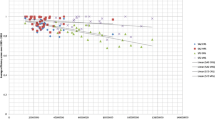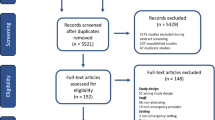Abstract
We examine operating room productivity on the example of hospitals in Germany with independent anesthesiology departments. Linked to anesthesiology group literature, we use the ln(Total Surgical Time/Total Anesthesiologists Salary) as a proxy for operating room productivity. We test the association between operating room productivity and different structural, organizational and management characteristics based on survey data from 87 hospitals. Our empirical analysis links improved operating room productivity to greater operating room capacity, appropriate scheduling behavior and management methods to realign interests. From this analysis, the enforcing jurisdiction and avoiding advance over-scheduling appear to be the implementable tools for improving operating room productivity.
Similar content being viewed by others
Notes
We would like to thank one of the reviewers for pointing out that readers of scheduling and anesthesiology group literature might be interested in what incision-to-closing hours per day were. We calculated an average incision-to-closing per anesthesiologist on payroll of 2.075 hours per day. It must be remembered that this does not equate either to incision-to-closing time for an individual operating room, ASA billable hours or even the anesthesia time for an anesthesiologist assigned to an OR work slot for any given day. We calculated that, simply based on the inability to staff more than one OR simultaneously and the limitation of an 8 hour workday, a German anesthesiologist is only able to conduct 57% as much anesthesia per year as his or her counterpart in a country with certified registered nurse anesthesiologists or their equivalent. The additional burden of administrative duties and the pre-operative screening requirement will further decrease this percentage.
The assumption that costs for servicing the intensive care unit are a constant proportion of total anesthesiologists costs is justified by the legal and institutional environment in Germany. Hospital can neither freely choose the size of their intensive care unit nor the size of any other department or unit within the hospital. Every hospital in Germany has the duty to provide a certain level of care (Versorgungsauftrag). There are 6 different levels, and the definitions of these levels of care are very precise and explicitly address issues like which departments a hospital has to have and which size these departments are likely to have. Additionally, the compensation system in 2002 was structured such that any deviation from the specified level of care results in financial disadvantages. The correlation of different scale and scope parameters provided in Table 4 underline the static structure of the German hospital system and show that our data set is representative of the German environment. However, we acknowledge that this assumption is not appropriate for a US dataset, and, hence, repeating our analysis as described for US data would not lead to sound results.
References
Bach A (2001) Anforderungen an das System OP-Organisatorische Voraussetzung/Kosten. Zentral Blatt für Chirurgie 126:336
Dexter F, Weih L, Gustafson R, Stegura L, Oldenkamp M, Wachtel R (2006) Observational Study of operating room times for knee and hip replacement surgery at nine U.S. community hospitals. Health Care Manag Sci 9:325–339
Abouleish A, Prough D, Whitten C, Zornow M (2003) The effects of surgical case duration and type of surgery on hourly clinical productivity of anesthesiologists. Anesth Analg 97:833–8
Barker S (2001) Lord or vassal? Academic anesthesiology finances in 2000. Anesth Analg 93:294–300
Abouleish A, Prough D, Zornow M, Lockhart A, Abate J, Hughes J (2001) Designing meaningful industry metrics for clinical productivity for anesthesiology departments. Anesth Analg 93:309–312
Dexter F, Epstein R, Marsh H (2001) A statistical analysis of weekday operating room anesthesia group staffing costs at nine independently managed surgical suites. Anesth Analg 92:1493–1498
Abouleish AE, Prough DS, Whitten CW, Zornow MH, Lockhart A, Conlay LA, Abate JJ (2002) Comparing clinical productivity of anesthesiology groups. Anesthesiology 97:608–615
Abouleish A, Prough D, Barker S, Whitten C, Uchida T, Apfelbaum J (2003) Organizational factors affect comparisons of the clinical productivity of academic anesthesiology departments. Anesth Analg 96:802–812
Witt MJ (2001) Improving group practice performance with benchmarking. Health Financ Manag 55:67–70
Becker ER, Hall K (2001) Physician services in an academic neurology department: using the resource-based relative-value scale to examine physician activities. J Health Care Finance 27:79–91
McIntosh C, Dexter F, Epstein RH (2006) The impact of service-specific staffing, case scheduling, turnovers, and first-case starts on anesthesia group and operating room productivity: a tutorial using data from an australian hospital. Anesth Analg 103:1499–1516
Dexter F, Macario A (2004) When to release allocated operating room time to increase operating room efficiency. Anesth Analg 98:758–762
Epstein RH, Dexter F (2002) Uncertainty in knowing the operating rooms in which cases were performed has little effect on operating room allocations or efficiency. Anesth Analg 95:1726–1730
Statistiches Bundesamt (2005) Gesundheitswesen: Grunddaten der Krankenhäuser und Vorsorge- und Rehabilitationseinrichtungen Fachserie 12/ Reihe 6.1
Kuntz L, Vera A (2005) Transfer pricing in hospitals and efficiency of physicians: the case of anesthesia services. Health Care Manage Rev 30:252–269
Dexter F, Lubarsky DA, Blake JT (2002) Sampling error can significantly affect measured hospital financial performance of surgeons and resulting operating room time allocations. Anesth Analg 95:184–188
Geldner G, Eberhart LH, Trunk S, Dahmen KG, Reissmann T, Weiler T, Bach A (2002) Effizientes OP-Management: Vorschläge zur Optimierung von Prozessabläufen als Grundlage für die Erstellung eines OP-Status. Anaesthesist 51:760–767
Brinkmann A, Isenmann R, Gebhard F,Georgieff M (2002) Zentrales OP Management- Ein Erfolgsfaktor für die Zukunft
Riedl S (2003) Modernes Operationsmanagment im Workflow Operation: Aufgabenspektrum und Herausforderungen der Zukunft. Anaesthesist 52
Hanss R, Buttgereit B, Tonner P, Bein B, Schleppers A, Steinfath M, Scholz J, Bauer M (2005) Overlapping induction of athesthesia. Anesthesiology 103:391–400
Schuster M, Standl T, Reißmann H, Kuntz L, Schulte am Esch J (2005) Reduction of anesthesia process times after the introduction of an internal transfer pricing system for anesthesia services. Anesth Analg 101:187–194
Davis RC (1951) The fundamentals of top management. Harper and Row, New York
Eastaugh SR (2001) Hospital costs and specialization: benefits of trimming product lines. J Health Care Finance 28:61–71
Wong K, Birks D (2004) Surgical risk management: the value of a weekly surgical radio-pathological meeting. ANZ J Surg 74:205–209
Locke EA (1982) The ideas of Frederick W. Taylor: an evaluation. Acad Manage Rev 7:14–24
Watkins WD (1997) Principles of operating room organization. Acta Anaesthesiol Scand Suppl 41:113–115
Barnard CI (1938) The functions of the executive. Harvard University Press, Cambridge
Cyert RM, March JG (1963) A behavioral theory of the firm. Prentice-Hall, Englewood Cliffs
March JG, Simon HA (1958) Organizations. Blackwell, Oxford
Simon HA (1976) Administrative behavior: a study of decision-making processes in administrative organizations. Free Press, New York
Tobin J (1958) Estimation of relationships for limited dependent variables. Econometrica 26:24–36
Johnston J, DiNardo J (1997) Econometric methods, 4th edn. McGraw-Hill, New York
Kmenta J (1997) Elements of econometrics, 2nd edn. University of Michigan Press, Ann Arbor
Long JS (1997) Regression models for categorical and limited dependent variables. Sage, Newbury Park
Maddala GS (1992) Introduction of econometrics, 2nd edn. Macmillan, New York
Dexter F, Coffin S, Tinker JH (1995) Decreases in anesthesia-controlled time cannot permit one additional surgical operation to be scheduled during the workday. Anesth Analg 81:1263–1268
Author information
Authors and Affiliations
Corresponding author
Rights and permissions
About this article
Cite this article
Berry, M., Berry-Stölzle, T. & Schleppers, A. Operating room management and operating room productivity: the case of Germany. Health Care Manage Sci 11, 228–239 (2008). https://doi.org/10.1007/s10729-007-9042-7
Received:
Accepted:
Published:
Issue Date:
DOI: https://doi.org/10.1007/s10729-007-9042-7




